Random
Shots
- Northern Apennines -
Armored Training | Eboli to Rome | To the Arno | Northern Apennines Po Valley | Vicenza Combat | Post-War | At Ease
 |
"It's just on the other side of that mountain." For every mountain climbed in Italy, an even taller one appeared ahead. Here an M4A1 of the 752nd takes one more hill. The mountainous terrain of Italy made offensive operations exceptionally difficult. |
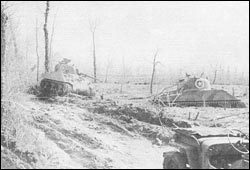 |
The mud was everywhere in Italy. One M4 of the 752nd tries to free another M4 that is bogged down in the mud near Firenze in 1944. When the mud froze, tanks such as this one would literally become frozen in place. Note the camouflage paint scheme on the tank to the right. |
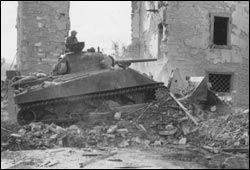 |
The 752nd was equipped with tank dozers, which were used to clear obstacles so the tanks could advance. Here a 752nd tank dozer clears rubble in the town of Firenzuola on 23 September 1944. Four weeks later, a tank dozer of C Company struck a mine in a stream bed, killing one man and wounding three others. (Official U.S. Signal Corps photo). |
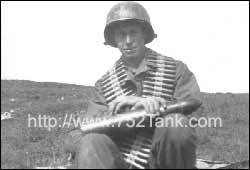 |
Sgt. Ray Holt of B Company in the Northern Apennines, September 1944. Sgt. Holt is shown with a belt of .50 caliber machinegun bullets, and is holding a 75mm AP M72 (AP-T) Armor Piercing shell with tracer. This photo was taken at Hill 966, also known as Tre Poggioli or "The Rock." |
 |
Some 752 vets recall a monument to WWI tankers on the top of Hill 966 (Tre Poggioli). The monument was actually built in tribute to Mussolini, and featured a highly stylized WWI tank and an equally stylized 52-foot high airplane rudder. The monument was dedicated on 29 August 1939, and was torn down after the war. Another monument on Hill 966 honors an Italian pilot who crashed at Hill 966 in 1934 while Mussolini was delivering a speech a short distance away. |
 |
Capt. Gayle Stockdale of B Company observing the effects of artillery fire on Monte delle Formiche, 10 October 1944. The official caption on the back of the original photo incorrectly states that it was taken at Borgo di Bisano, but in reality it was taken from the church at Castelnuovo di Bisano, a short distance away. The original caption date of 6 October 1944 is also incorrect. The 752nd was undergoing maintenence and resupply 6 miles to the south on the 6th, which was a day of heavy rain. The B Company morning reports show that Stockdale and two tanks first arrived at the Castelnuovo di Bisano church on 9 October after a stiff firefight there. The artillery bombardment of Monte delle Formiche which Stockdale is observing began on 10 October. Stockdale left this location on 10 October and began the advance on Monte delle Formiche later that day. (Official U.S. Signal Corps photo). |
 |
Two tanks of B Company in indirect fire positions. These tanks have been in this position for some time, as evidenced by the large and neatly stacked pile of shell casings. Note the use of tarps for simple but effective camouflage. |
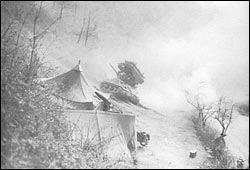 |
An M4A1 rocket tank firing on a hillside in the Apennines. The rocket tanks had a high output, but the fire was not very accurate. The rocket tanks were top-heavy and attracted considerable fire from the Germans. The 752nd operated four 4.5" rocket tanks, which the men called "Buck Rogers" in reference to the futuristic comic book character. Click here for a details about the development and use of rocket tanks in the 752nd. |
 |
An M4A1 of C Company and two M18 Hellcats of the 805th TD Battalion attempt to tow a disabled M4A1 up a hill on 11 December 1944. The location was near a forward observation post, and was under direct observation by the Germans. (Official U.S. Signal Corps photo). |
 |
The winter of 1944 - 1945 was unusually harsh. This photo was taken near the Assault Gun position at Ca Bassa. The men of the 752nd endured the bitter cold winter inside their tanks, tents, bombed out buildings, and even caves. |
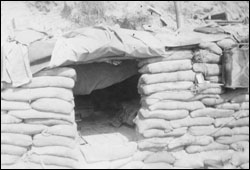 |
This B Company dugout is typical of the shelters the men of the 752nd occupied during the winter of 44-45. This shelter was dug out of the mountainside and covered with sandbags and a log roof for protection from artillery bursts. |
 |
Another photo of a B Company dugout shows the proximity between the dugout and the tank. This dugout is reinforced with a timber and sandbag roof. The large pile on top of the roof is a bale of hay for bedding, covered with flattened cardboard boxes to keep it dry. The pile also helps to break the profile of the tank and make it harder to spot. |
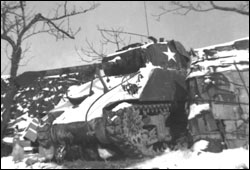 |
The same M4A3 76mm tank as in the photo above. The tank is parked close to the cardboard covered pile of hay. A small garbage dump is on the other side of the tank. Note the canvas covering on the main gun, which is secured to the travel bracket. |
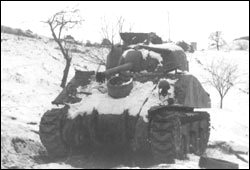 |
The winter was rough on the equipment. Turrets had to be thawed with blow torches when ice formed in the turret races. Tracks literally froze in place. Note the T48 rubber chevron track blocks on this "vintage" 752nd M4, and the old bogey wheel on the front glacis plate for added protection. Also note the old 3-piece transmission cover. |
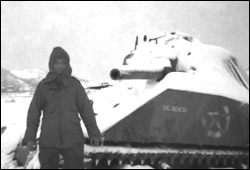 |
A tanker stands next to B Company's 105mm Assault Gun named "Big Bichess." Note how a tarp had been draped over the turret prior to the snowfall. The old style sighting vane can be seen on the turret's right side (center of photo). Also note the old Allied star insignia on the sponson. |
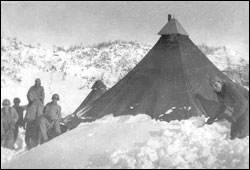 |
The winter was also rough on the men. Here some men of B Company of the 752nd dig out after yet another big snowfall in the mountains. |
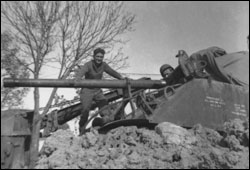 |
A 76mm M4A3 of B Company, somewhere in the Northern Apennines. The Ornance Depot stencils indicate that the tank was processed 12 October 1944, though the 752 did not receive their 76mm tanks until February 1945. The main gun is not equipped with a muzzle brake, but instead is capped with a muzzle brake thread protector. Note the discoloration of the end of the main gun, indicating that it has seen a fair amount of firing. The boom of a T-2 tank recovery vehicle can be seen in the background. |
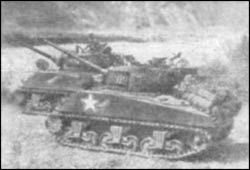 |
In the Northern Apennines, the 752nd tanks were used mainly in indirect fire support roles. Here, two of the new 76mm M4A3s from HQ are shown providing indirect fire support. Note the elevation of their main guns. This photo was taken sometime in March or early April of 1945. |
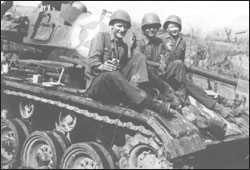 |
D Company received a full complement of M24 light tanks in March 1945, but had to turn them over to the 1st Armored Division in early April 1945. The light tankers went on to distinguish themselves with their old M5A1 Stuart tanks in the Po Valley Campaign, and received M24 tanks again in the postwar period. |
Researched and Written by Robert
J. Holt
Page Content Copyright 2003 - 2025 Robert J. Holt
All Rights Reserved